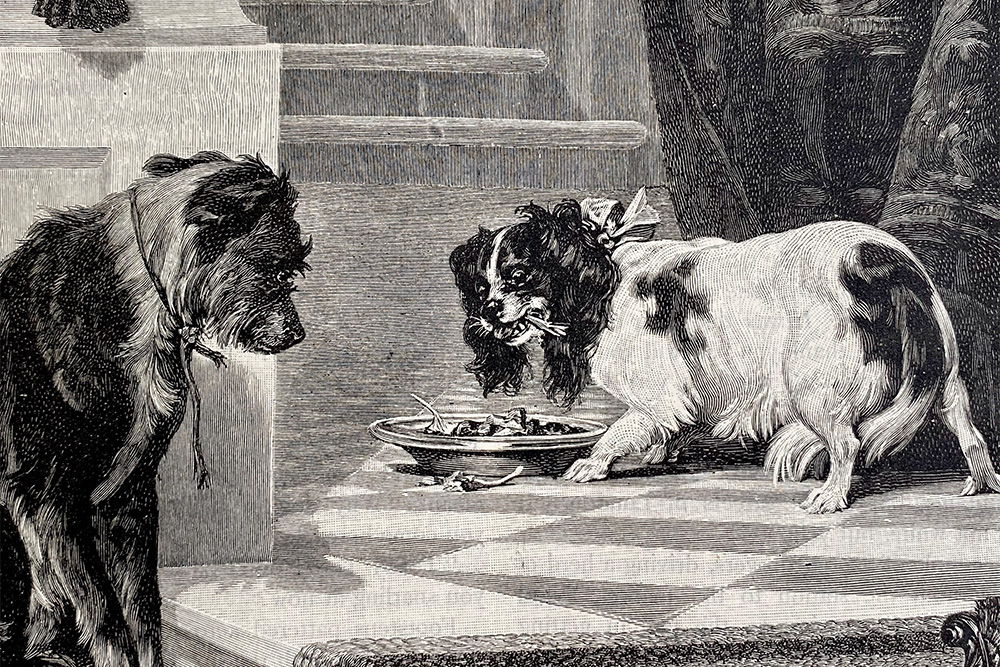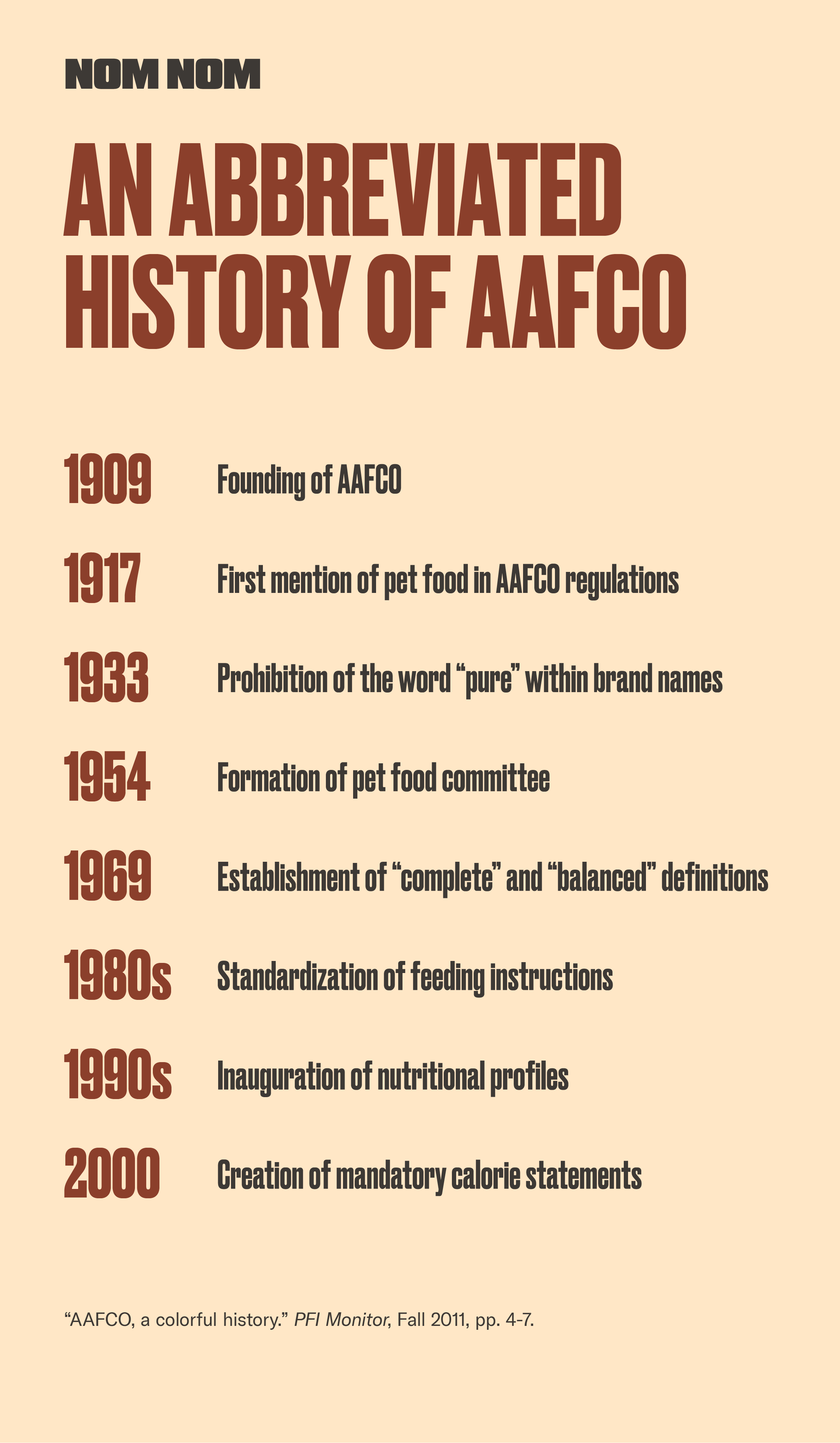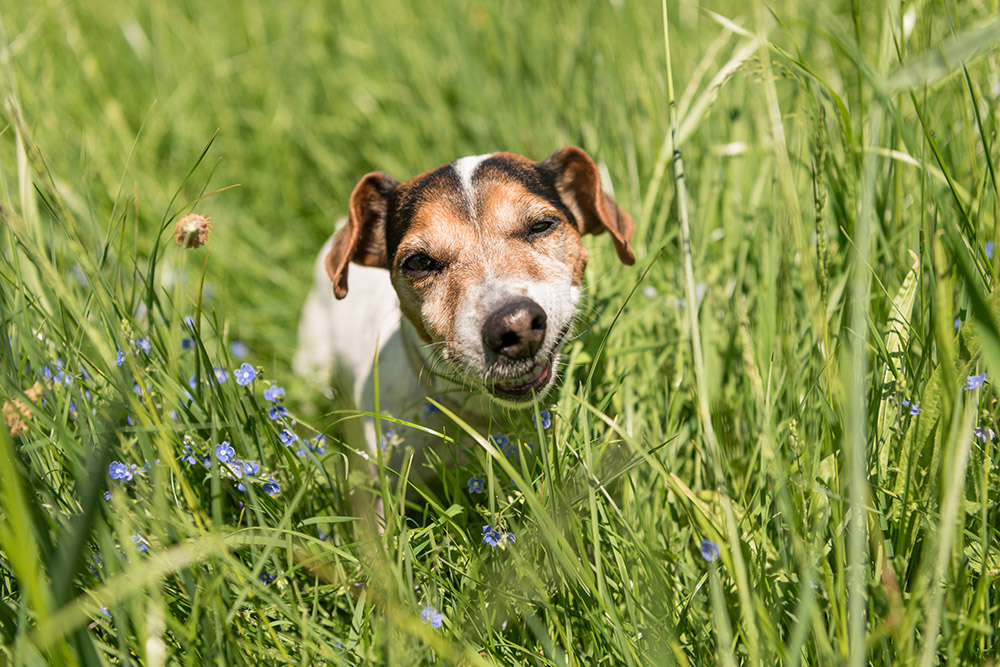Learn : Food & Nutrition
An Annotated History of Dog Food
Ancient Feeding | First Commercialized Dog Food | AAFCO | Wartime Feeding | Kibble Boom | Modern Dog Food
For as long as we’ve had dogs, we’ve had dog food.
Well, sort of. “Dog food” has meant a lot of different things over the generations. In fact, “dog food” wasn’t even a term in the way we know it until an electrician by the name of James Spratt waltzed into the picture in the mid-1800s. And even then, “dog food” was something of a neologism. More on that later.
Relations weren’t always sunshine and gumdrops between us and our best friends. Trot your way back in history 20,000 to 30,000 years ago, and you’ll find yourself in a tooth-and-claw battle for food, for raiment and for territory between our great-great-great-great-great-great grandparents and their great-great-great-great-great-great grandwolves.
Luckily, cooler heads prevailed. No one knows exactly when or how we brokered the détente — many suggest there could have been more than one domestication event per millenia.
But peace is peace. Why question a good thing?
So, humanity, you got a dog...
Now what? As a companion, guardian, hunting partner and contributing member to a feudal society, it’d be cruel not to feed it something. Anything.
“Anything” is probably the right word. Dogs and their wolven ancestors have subsisted on many different diets over the course of the years. And we use the term “diets” liberally. From sinew to tofu, dogs are resilient creatures with surprisingly versatile stomachs that have adapted and reformed themselves to human habits. Best friends forever.
The Romans had a saying. Well, Virgil had a saying (and that guy knew his way around a saying): “Nec tibi cura canum fuerit postrema; sed una Veloces Spartae catulos, acremque Molossum, Pasce sero pingui.”
For those of you who don’t frequent the Continent, it roughly translates to "Do not let the care of dogs be last; but the swift Spartan hounds, and fierce Mastiff, Feed the whey.”
Which brings us to one of our first dishes of the evening.
Yes Whey
Classical antiquity recorded some of the earliest instances of domesticated dogs and their typical diet. While the Greeks’ canine mythologizing was perhaps borrowed from their Egyptian neighbors, the Helenic tradition developed plenty of its own philosophies on how dogs should be handled, treated and fed.
Xenophon and Arrian, two pre-renaissance renaissance men, developed hunting manuals for the average Greek as early as 430 BC, shedding light on the most popular meals for the average hunting dog:
The Greeks loved a good hierarchy. Heck, they invented the word. As a result, prized hunting dogs and promising puppies might enjoy a little extra something with their barley and whey — ox liver, rabbit and other small game may have been considered delicacies of the day.
Meanwhile, in Ancient China…
The harbingers of modern dog food were already well into production. While it wouldn’t be another few thousand years before anyone thought to bag it, brand it and shelve it, many of kibble’s precursor ingredients dominated the countryside harvest:
Rice, for example, was beginning to develop its still-standing reputation as a staple ingredient for dogs. Domesticated in China, short-grain rice quickly became part of the Eastern tradition for both Chinese citizenry and their loyal companions.
Same goes for pork and millet, a common meat and a common grain you’ll still find in dog foods of today. Both were farmed and processed at factory-like rates, with advanced harvesting techniques used to feed large swaths of China’s rapidly growing human and canine populations.
The Mesoamerican Diet
While Greek and Chinese dogs continued to feast on a surprisingly diverse set of grains and meats, dogs living alongside the Maya civilization were perhaps a little more restricted in their diets.
Many members of the Maya city-states not only revered dogs, but worshiped them. Thought of as mediators between the living and the dead, regional folklore appreciated a dog’s ability to guide humans through the afterlife. As you can imagine, Maya dog parents had some incentive to keep their pets content and well fed.
Known for its maize production, the Maya people often had access to an abundance of the domesticated cereal grain. As such — and as dogs began making their way into homes as opposed to foraging for themselves — most nibbled on leftover corn as a primary source of nutrition.
Corn is part of a balanced dog diet. And related allergies are rare. Loaded with fiber and carbohydrates, it’s capable of providing the energy dogs need to seize the day. That said, it’s best accompanied by the nutritionally sound meats and veggies you’ll find in… oh we don’t know… recipes like ours, perhaps?
Time wore on
Dogs continued their adorable creep into our teepees, huts and homes. And as humankind steadily grew more advanced, more compassionate and more connected, the human-dog relationship began to take a shape that resembles something closer to what we’d recognize today.
In Medieval Europe, for example, dogs were still fashionable mousers, birders and protectors. Though some family units began to simply keep them around for companionship.
Awww.
These friend-dogs were often fed the butcher’s castaways: Offal, entrails and other parts of the cow were seen as a cheap, efficient and decent way of keeping a dog’s belly full. If a dog were lucky enough to be born or bred into royalty, they may have even enjoyed the luxuries of a homemade stew or choice cut of meat.
Zooming back to China, the legendary Empress Dowager Cixi was known to dress her Pekinese in fine cloth, lodge in their own bamboo hut and chow down on delicacies like quail and shark fin. Not a bad gig.
It wasn’t until the mid-1800s when a man named James Spratt (remember? From earlier?) saw a business opportunity in feeding dogs, changing the landscape of dog food once and forever.
One fateful visit to London
Mr. Spratt, an electrician hailing from Ohio, was an enterprising mind. An electrician by trade, his travels eventually sailed him to London on an expedition to sell the newly-invented lightning rod to local merchants and aristocrats.
Instead, what he found waiting for him at the ports of London was a far more lucrative idea: the dog biscuit.
Dog biscuits have an entire history of their own. In European cultures, it’d become customary to feed stale bread to dogs — biscuits by another name. “Dog’s bread,” in fact, might have been something of an insult at the time used to criticize one’s cooking. How rude.
His inspiration for the dog biscuit came when he noticed sailors feeding their ship’s leftover supplies of hardtack to dogs prowling the quays. It was simple, affordable and — to his eyes — as tasty to a dog as anything else.
There’s a little truth to the idea that a dog will eat anything. With only about 1,700 tastebuds to our 9,000, there really is a reason they see no problem lapping up that pizza crust off the dirty linoleum. That said, dogs can taste and do appreciate a little variety in their lives. Dog biscuits were a good place to start, but hardly the finish line.
Home again, home again
It didn’t take long for Spratt’s biscuits to find their footing. In fact, Spratt’s decision to relocate his now-booming biscuit empire back to the United States put mass-produced dog food on the map. As a businessman at heart, Spratt likely knew what was coming next: Dozens (if not hundreds) of competitors, all duking it out in the laissez faire wellspring of early American industry.
The Industrial Revolution had changed things — not just for people, but for dogs, too.
- Manufacturing and production methods had gained serious steam (pun mildly intended), and the advent of mechanized processes and automation had reified Spratt’s vision: a tin of biscuits in every American home.
- The wealth of production facilities and capabilities led to new surpluses that many Americans never would have expected just decades earlier. Namely? Horse meat (more on that later).
- The expansion of shipping and delivery applications, including the American railway system and creation of the first automobile, allowed both dog biscuits and excitement around dog biscuits to travel faster than ever before.
Of course, nutritional science was still in its infancy in the 17- and 1800s. Let alone pet nutritional science.
Dogs didn’t fascinate the scientific community until much closer to the modern era. In the early 1900s, one Ivan Pavlov began his canine studies on classical conditioning with a bell, some tasty morsels of food and a very patient litter of dogs.
Little known fact. Pavlov’s Nobel Prize actually didn’t come from his world-renowned conditioning studies, but instead his work with the animal digestive system. His inspection provided some of the most advanced insight into the GI tract at the time.
Making it official
By the late 1800s, dog biscuits were the talk of the town. A more humane method of treating animals had officially been set into motion, as agrarian communities and farm owners began to adopt new mental models for how they treated both their pets and their livestock.
In 1896, Massachusetts became the first American state to enact a feed law. Maine and Vermont weren’t far behind, enacting animal feed regulations of their own in 1898. According to the American Feed Industry Association, “These first feed laws were ‘truth-in-labeling’ laws, meant to protect farmers from those who sold poor-quality ground ingredients, byproducts or mixtures, putting the onus on ingredient manufacturers to determine feed values.”
Out of the American Feed Industry Association and regulatory bodies like it, grew AAFCO, the Association of American Feed Control Officials. AAFCO’s status as a pet food authority — to this very day — is often misconstrued.
Think of AAFCO as a well-knit body of knowledgeable animal food experts spanning across state lines. Together, these experts work with state and federal officials to enact higher, safer standards when it comes to feeding time.
In time, AAFCO took the reins as the leading voice in what was — and wasn’t — proper for a pet dog’s bowl.
Wartime & the can
The 1900s brought more than just a roster of new biscuit competitors and a de facto governing body to oversee their composition. As families all over the world now adopted dogs as companions, demand grew for a simple, twice-a-day meal that almost any dog would eat. Something convenient. Something accessible. And most of all, something shelf stable.
And like that, canned dog food was born.
As for all that aforementioned horse meat? You can probably see where this fun fact is headed. (Queasy stomachs — feel free to skip ahead.) With the proliferation of the motor vehicle rapidly spreading across the world, horses lost some of their luster to even the average homesteader. By 1922, canned dog food began to pop up featuring — you guessed it — horse meat as a key ingredient.
While the can solved many supply issues for dog owners the world over, it still had a few holes in its game:
- Expiration dates came sooner than most anticipated. While the shelf life of a canned food was certainly longer than whatever table scraps a dog may have been feasting on before then, it wasn’t infinite.
- For Americans and many other nations, World War II brought about rationing measures. Domestic consumption of everything from gasoline to sugar slowed to a crawl, and most tin production was diverted toward the military. As such, canned food producers no longer had a reliable container for shipping and storing their product.
As necessity once again proved itself the mother of invention, the now-developed dog food industry began to look in new directions for creating, storing and distributing dog food.
By the 1950s, Spratt’s turned in a new direction. The former king of the dog biscuit was acquired and absorbed by cereal behemoth, General Mills. Interestingly enough, Spratt’s and its competitors had developed more modern techniques by this point, joining General Mills’ portfolio of bone-shaped biscuits famously formulated with vitamins, oils and more health-forward ingredients than you may have expected for the time.
The kibble boom
With aluminum in short supply and a feverish public interest in quick, ready-made meals, the very first kibble arrived on the scene. In 1956, dog food manufacturers began to formulate dog food through a new process dubbed extrusion.
Before 1956, dog foodies were experimenting with proto-kibbles. “Meat meals” made from overcooked powders sprung up in the ‘20s but it wasn’t until extrusion came around that kibble found its wings.
Extrusion, at its simplest, was (and still is) a method of flash-cooking raw ingredients at extremely high temperatures in order to create a uniform, pellet-like product that resembles the kibble you still see today. Once sprayed with taste-enhancing chemicals and preservatives, the kibble was bagged into enormous quantities and sent to market.
While the efficiency and predictability of kibble propelled it to near-instant popularity, it didn’t come without stumbling blocks.
- Kibble’s expedience may have jumped right over the most important quality of all (to a dog, that is): flavor. Today’s palatability studies suggest that the higher-moisture kibbles and alternatives may be more attractive to a dog’s appetite.
- Over time, select kibbles’ production processes could have resulted in nutritional deficiencies and digestibility issues in dogs, promising certain nutrition levels while delivering others.
So where does that leave us today?
Kibble is still very much alive and well in the hearts of dog owners — if you’re reading this, there’s a decent chance it’s what your family dog grew up on.
But as pet science advanced and pet parents grew increasingly curious about what could keep their dogs working, playing and eating at their best, two new types of dog food entered the picture:
1. Raw food, which wouldn’t be exactly fair to characterize as “new,” began to gain steam in purist communities. A raw food diet does its best to emulate the thousands-of-year-old diets discussed earlier, avoiding extrusion, overprocessing or cooking altogether.
2. Fresh food, made with real, whole ingredients came about as a potential solution to many of the allergies and autoimmune conditions that plague many breeds.
Some point to the Food Safety Modernization Act (FSMA) as the spark the dog food industry needed. Signed into law in 2011 and intended to help clamp down on foodborne illness in human food, the law specifically covers pet food in its purview. The new regulation inspired both manufacturers and customers to think differently about the sourcing, packaging and handling of their pet food, and provided AAFCO with the support it needed (namely, the FDA) to truly make changes for the better.
The rising consumer demand for fresh and raw diets — sometimes homemade, sometimes delivered — has led to a whole new way of looking at food: something to help dogs flourish, rather than simply survive.
We’d be remiss if we didn’t vouch for fresh food ourselves. While at first glance, the meat-and-veggie exterior may remind you of those prehistoric meals we mentioned some two thousand words ago, the truth is, fresh food represents an evolution in dog food.
- Gently cooked fresh food, as opposed to extruded food (or simply uncooked food) can help bring out the maximum amount of nutrition in every ingredient, whether that ingredient is a chicken thigh, a baby carrot or a kale stem. It also helps bring out maximum taste — ergo maximum mealtime enjoyment.
- Fresh food has scientifically proven its worth as a more digestible option for dogs with or without GI issues.
- Real fresh food can’t be faked, with quality ingredients visible to the naked eye. Plus, your dog won’t get any of the hidden synthetics, fillers or mystery ingredients you’d likely find in dog food iterations of generations past.
Dog food has certainly lived a life, from horse meat and fillers to savory chicken and wholesome veggies. We can’t wait to see what comes next in the exciting saga of pet food, but no matter what, you can rest assured that we’ll be right there beside you and your paw-footed family, tails wagging and ready to dig in.






 How to Introduce a Dog to a Baby
How to Introduce a Dog to a Baby
 For the First Time Puppy Owner : 7 Signs You’re Doing it Right
For the First Time Puppy Owner : 7 Signs You’re Doing it Right
 How Dogs Show Their Love
How Dogs Show Their Love
 7 Winter Pet Protection Tips
7 Winter Pet Protection Tips
 Why Do Dogs Eat Grass?
Why Do Dogs Eat Grass?
 Crate Training a New Puppy
Crate Training a New Puppy